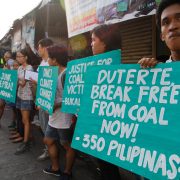Islamic State Occupation Wrecks Iraq Environment and Infrastructure
UNEP report provides initial tally of contaminated sites and destroyed water systems.

Residents of Qayarrah, in northern Iraq, must contend with oil leaks from sabotaged oil wells and refineries. Photo courtesy of UNEP
By Brett Walton, Circle of Blue
For nine months the Qayarrah oil field burned. Smoke from 18 oil wells that Islamic State militants blew up in June 2016 blotted the sky south of Mosul, the largest city in northern Iraq, for miles.
Tens of thousands of civilians have died and more than 3.2 million people in Iraq have been driven from their homes since fighting against Islamic State began in 2014. When, or if, they return, the domestic refugees will encounter a landscape disfigured by years of war. Oil spills and chemical burns have poisoned the earth. Water pipelines were bomb targets while dams and canals were wielded as weapons of war.
The extent of the damage in northern Iraq, where fighting was most intense, is just beginning to be appraised. A preliminary assessment by the United Nations Environment Program, conducted in July and August, reveals a swath of ecological devastation around Mosul, which the Iraqi Army retook from Islamic State on July 9.
Through field surveys and interviews with Iraqi government officials, UN agency staff, local academics, and oil company employees, UNEP found a region whose refineries, power stations, pharmaceutical manufacturing complex, canals, dams, and mines have been bombed, sabotaged, or punctured, resulting in a toxic flow onto lands and waters.
Residents of Qayarrah, a town of 23,000 adjacent to the bombed oil field, must contend with oil from a sabotaged well that flowed into city streets and “remains highly contaminated,” the report states. Leaks from a destroyed refinery on the town’s outer edge filled wadis with tens of thousands of barrels of oil and created at least 23 petroleum lakes. Samples of drinking water, which residents get from the nearby Tigris River, and groundwater that were tested by UNEP showed elevated levels of mercury and lead. More testing needs to be done to determine the source of pollution, UNEP says.
Mosul, home to roughly 1.4 million people before the conflict began, is now in many areas a rubble pile. UNEP estimates that 11 million tons of debris — equivalent to three times the Great Pyramid at Giza — must be discarded.
Mosul’s old city, where 100,000 people lived before the war, is 90 percent destroyed, according to the report: “It is evident that the old city will need to be rebuilt anew.”
Reconstruction at this scale will place a heavy burden on local sources of raw materials. UNEP claims that Mosul officials have eyes on sand and gravel from the Tigris river bed. Such quarrying, however, is banned under national environmental law as it destroys rivers. UNEP will present a debris management plan to Mosul officials at the end of 2017.
Water As a Weapon
The battlefield against Islamic State crossed the Tigris and Euphrates, the great rivers of Mesopotamia that bisect modern Iraq from north to south. The array of dams and canals along the rivers were irresistible targets in the vicious war.
UNEP lists a half dozen instances in which water infrastructure was reportedly the target of attack or used as a weapon.
- In April 2014, Islamic State fighters seized the Fallujah Barrage, which regulates the Euphrates. The militants, for a time, halted river flows, which dried out marshes. Then they opened the barrage gates, flooding hundreds of square miles, damaging canals, and forcing some 12,000 families to evacuate.
- Islamic State took control of Mosul Dam, a rickety structure on the Tigris River, for two weeks in August 2014.
- For six months in the spring and summer of 2015, Islamic State essentially cut off the flow of the Euphrates to Iraq. IS controlled the Tabaqa Dam, located upstream in Syria.
The use of such tactics is not limited to Iraq. Peter Gleick is president emeritus of the Pacific Institute, which oversees the Water Conflict Chronology, a catalogue of conflicts over water or incidents in which water systems were targets of war. He told Circle of Blue that the database continues to grow.
“Conflicts and violence over water resources are growing not shrinking, because we’re failing to address the root causes of these problems, which is bad government, and inequitable access to water, unwillingness to abide by international principles, and all of the litany of challenges that cause the problem,” Gleick said.
Rebuilding will take time and money. The Iraq Ministry of Water Resources, in an initial survey, estimates the damage to water infrastructure in the country at $600 million. The final cost will likely be much higher.
UNEP plans a more thorough investigation of the ecological wounds in October and November in partnership with the Environment Ministry, said Rob Few, UNEP spokesman. Only 40 of 60 sites identified as polluted before the war have been assessed because of dangers to staff: landmines and booby traps.
Nearly as damaging as the physical wreckage is the deterioration of the region’s human capital. Islamic State disbanded the environmental departments of provincial governments. UNEP staff learned that all the assets of the Niniveh Environment Directorate — laptop computers, diaries, laboratories, air and water monitoring equipment, and office archives — were confiscated or looted and “lie in ruin.”
Brett writes about agriculture, energy, infrastructure, and the politics and economics of water in the United States. He also writes the Federal Water Tap, Circle of Blue’s weekly digest of U.S. government water news. He is the winner of two Society of Environmental Journalists reporting awards, one of the top honors in American environmental journalism: first place for explanatory reporting for a series on septic system pollution in the United States(2016) and third place for beat reporting in a small market (2014). He received the Sierra Club’s Distinguished Service Award in 2018. Brett lives in Seattle, where he hikes the mountains and bakes pies. Contact Brett Walton












